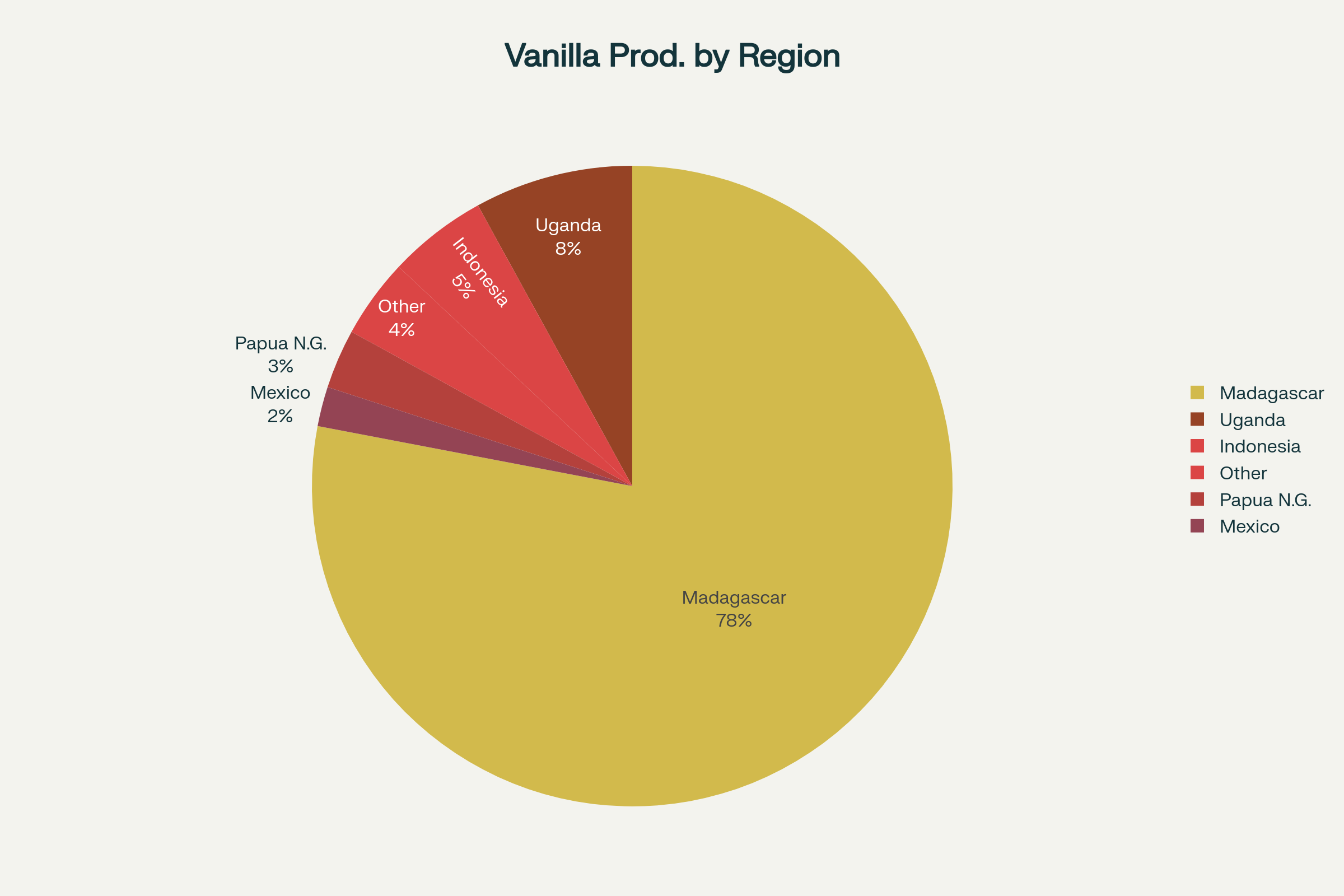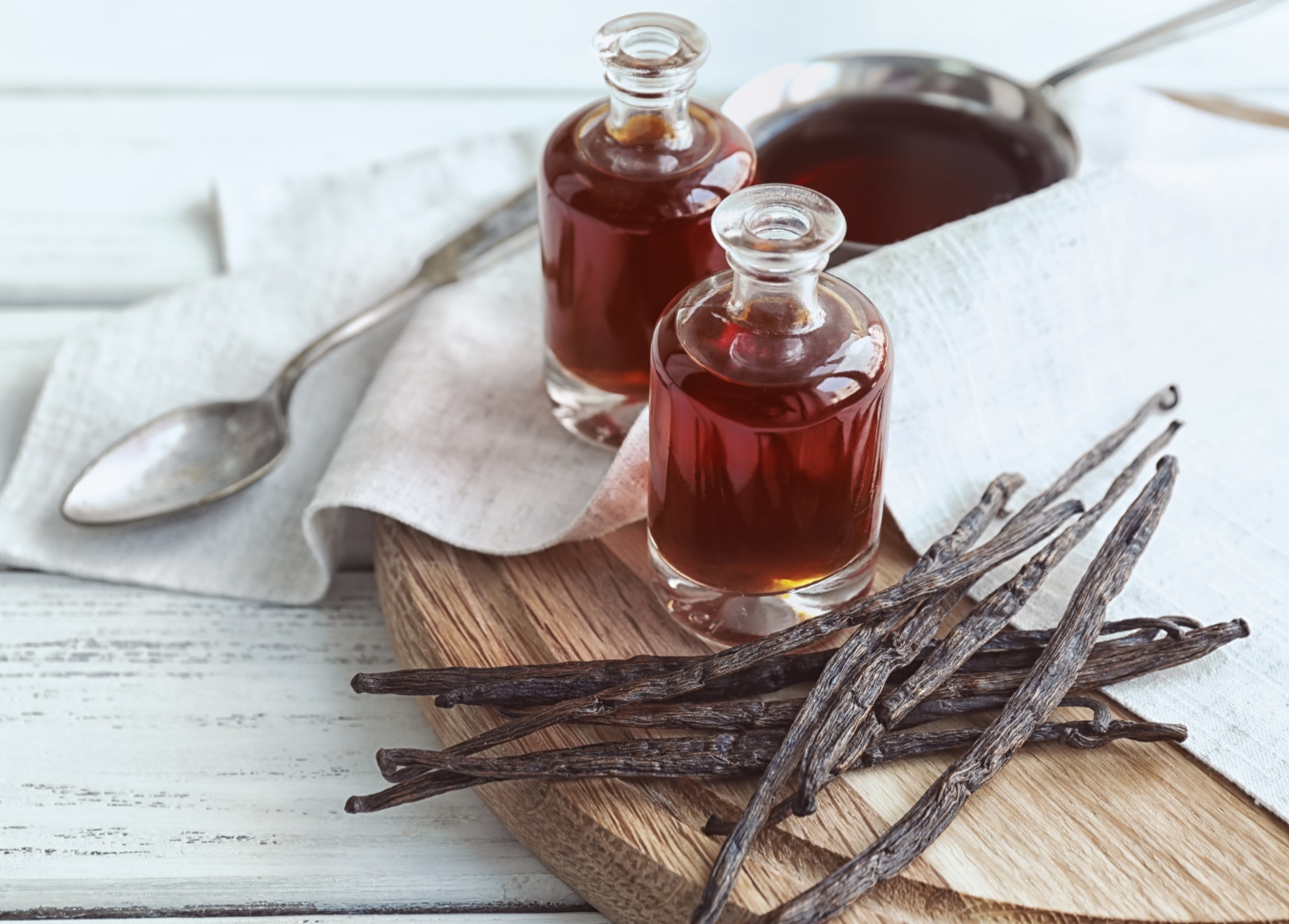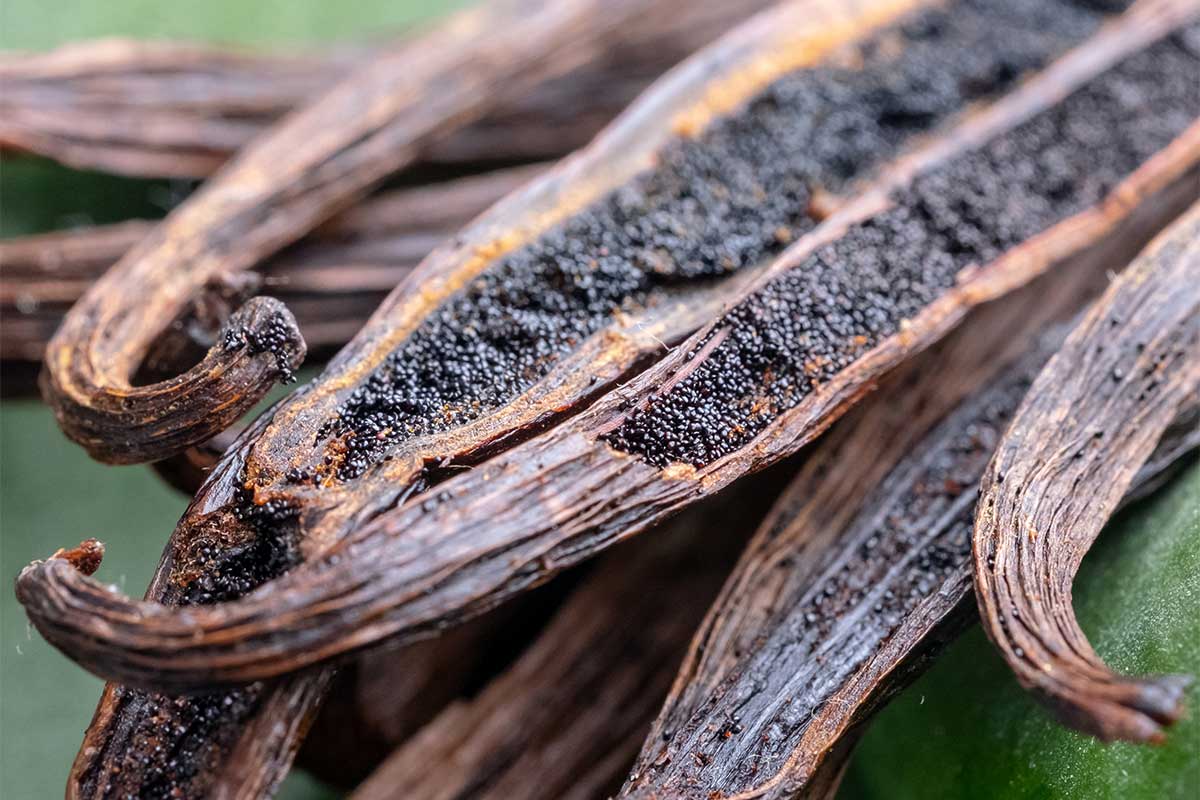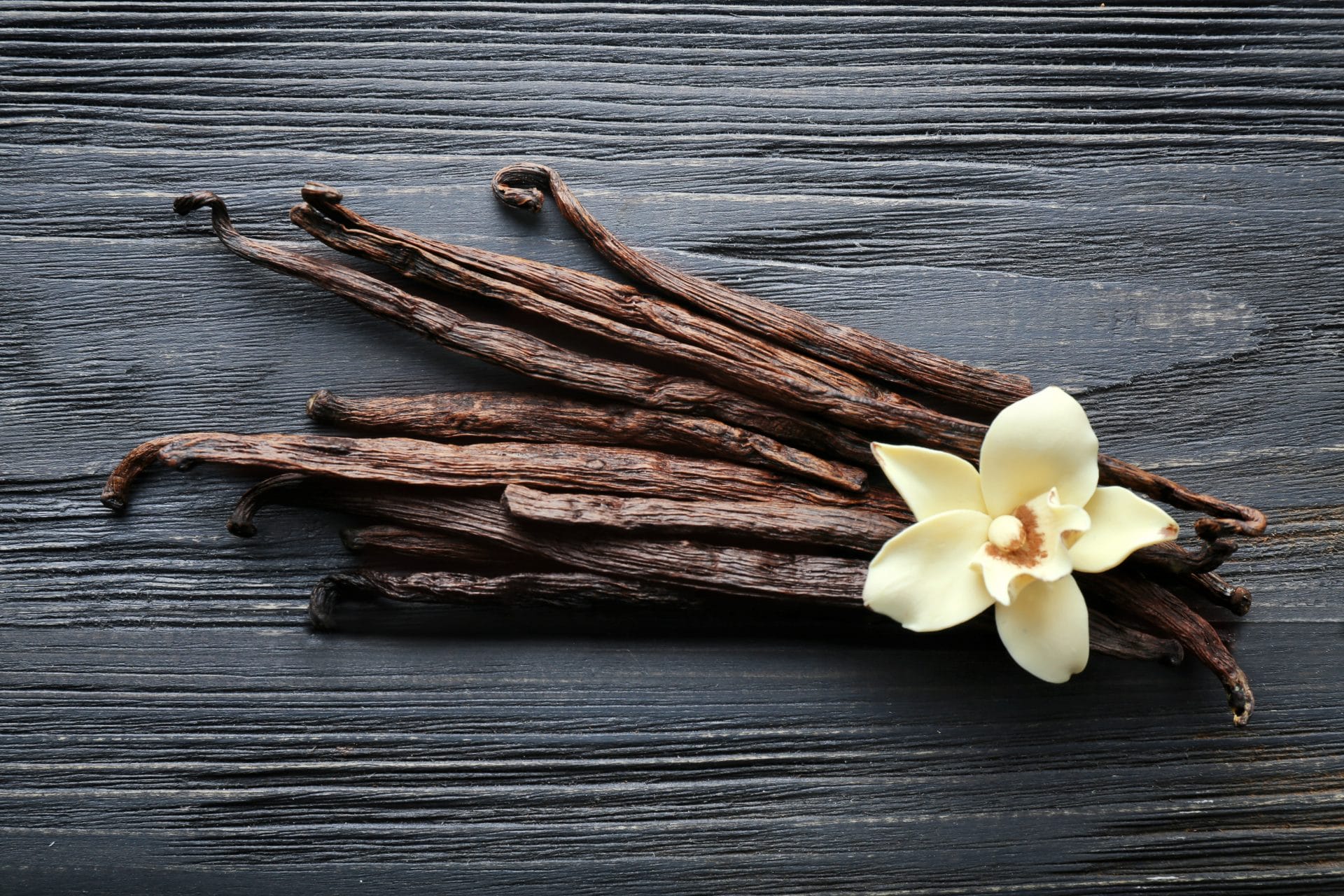In the aromatic landscapes of Madagascar, where 78% of the world’s vanilla is cultivated, farmers wake each morning to tend to one of the planet’s most precious and volatile agricultural commodities.The global vanilla market, valued at $3.61 billion in 2024 and projected to reach $5.17 billion by 2030, tells only part of the story. Behind these impressive figures lies a world of hand-pollinated orchids, labor-intensive curing processes, and farmers whose livelihoods hang in the balance of weather patterns, international demand, and price volatility that can swing from prosperity to poverty within a single growing season.
Climate Change Meets Vanilla Cultivation
Vanilla cultivation demands near-perfect environmental conditions that climate change is systematically disrupting. The vanilla orchid (Vanilla planifolia) requires temperatures between 21-32°C (70-90°F), 80-90% relative humidity, and 1,500-3,000mm of annual rainfall distributed evenly throughout the year. These exacting requirements make vanilla one of the most climate-sensitive crops on Earth, with even minor deviations causing significant impacts on flowering, pollination, and bean development.syg
Madagascar’s SAVA region (Sambava, Antalaha, Vohemar, and Andapa), the epicenter of global vanilla production, faces unprecedented climate challenges. Rising temperatures, shifting rainfall patterns, and increasingly frequent cyclones are fundamentally altering the conditions that have made Madagascar the undisputed vanilla capital for over a century.
Recent research reveals alarming projections for wild vanilla species and their pollinators. Climate change may reduce habitat overlap between vanilla orchids and their pollinating bees by up to 90% by 2050. This potential mismatch threatens not only wild vanilla populations but also the genetic diversity essential for developing climate-resilient cultivated varieties.cooksvanilla+1
Farmers in vanilla-growing regions report nearly universal experience of climate-related challenges. Three-quarters of surveyed farmers in Madagascar’s vanilla country report drying water sources, while many have reduced working hours due to extreme temperatures and torrential downpours. The emergence of new pests, increased disease pressure, and higher rates of malaria and diarrheal diseases further compound the challenges facing vanilla-dependent communities.

Global Vanilla Production by Region (2025)
Market Volatility of Vanilla The Boom and Bust Cycle
The vanilla market operates on a dramatic boom-and-bust cycle that has defined the industry for decades. The last peak-to-peak cycle lasted 13 years (2003-2016), and the current cycle has been running for nine years. This cyclical nature creates extreme price volatility that can devastate farming communities during downturns while generating unprecedented wealth during boom periods.
Current market conditions reflect a significant oversupply situation. Madagascar exported an enormous 4,300 metric tons in the first six months of 2024, as large industrial buyers capitalized on low prices to secure multi-year vanilla supplies. However, exports have been minimal in the latter half of 2024 and early 2025, as the market absorbed excess inventory and prices continued declining.
The 2025 Madagascar vanilla harvest is expected to produce between 1,600-1,800 tons of high-quality beans , but global vanilla supplies now exceed 6,000 metric tons when combined with Uganda (300-400 MT), Indonesia, and Papua New Guinea production. This abundance has created downward price pressure despite government attempts to maintain export price floors at $250 per kilogram.
Price volatility has been extreme over recent years. In 2018, vanilla reached peak prices of $442,649 per ton in the United States, before declining to $148,983 per ton by 2023. Current 2025 green vanilla prices in Madagascar have fallen to as low as $1.50/kg (7,000 Ariary), indicating continued market weakness.sciencenews+1
The Economics of Liquid Gold
Despite current low prices, vanilla remains one of the world’s most valuable agricultural commodities by weight. The labor-intensive cultivation process, requiring hand-pollination of each flower and months of careful curing, justifies vanilla’s premium positioning. Each vanilla orchid flower blooms for only one day, and must be hand-pollinated within 12 hours to produce a bean.
The curing process represents another critical value-addition stage. Fresh vanilla beans contain no vanillin—the compound that gives vanilla its distinctive aroma and flavor. The complex curing process, involving blanching, sweating, drying, and conditioning over 3-6 months, develops the vanillin content that determines quality and price.
Madagascar’s dominance stems from both ideal growing conditions and centuries of accumulated expertise. Malagasy farmers have perfected traditional growing and curing methods passed down through generations. The SAVA region’s volcanic soils, consistent temperatures, and cultural knowledge create vanilla beans with unmatched aroma profiles and vanillin content.
However, this economic success creates vulnerability. Vanilla-dependent farming communities bear the brunt of market downturns, with limited diversification options during price crashes. Many farmers lack access to storage infrastructure, financing, and alternative income sources, making them particularly vulnerable to boom-bust cycles.

Technological Innovation and Adaptation Strategies Vanilla
Farmers and researchers are developing innovative approaches to address climate and market challenges. Climate adaptation strategies include cultivation at higher altitudes, expanded use of shade trees, and implementation of early warning systems for extreme weather events. The Madagascar 2025 Climate Fund supports reforestation and agroforestry practices to improve soil health and crop protection.vanilleaix+1
Improved agricultural practices are being adopted across vanilla-growing regions. Farmers are implementing better soil health management, water conservation techniques, and integrated pest management systems. Some operations use shade nets and protective covers to regulate temperature and humidity, reducing plant stress and improving bean quality.
Traceability technology is transforming vanilla supply chains. Madagascar has implemented stronger traceability programs requiring every exported batch to be registered and traceable to its origin. Blockchain and digital tracking systems help combat fraud and ensure authentic Madagascar vanilla reaches international markets.
Research into vanilla genetics and breeding focuses on developing climate-resilient varieties. Scientists are studying wild vanilla species to identify genes that could improve drought tolerance, disease resistance, and heat adaptation. These genetic resources become increasingly valuable as climate change challenges traditional growing regions.
Global Market Dynamics and Consumer Trends Vanilla
Consumer preferences increasingly favor natural vanilla over synthetic alternatives. The global shift toward clean-label products, organic ingredients, and authentic flavors drives premium demand for natural vanilla. Major food and beverage companies are reformulating products to eliminate artificial vanillin in favor of natural vanilla extract.
The premium ice cream segment exemplifies this trend. Brands like Jeni’s Splendid Ice Creams, Van Leeuwen, and Häagen-Dazs emphasize real vanilla beans over synthetic vanillin, promoting authenticity and origin transparency. This creates opportunities for high-quality vanilla suppliers to capture premium pricing despite overall market oversupply.

Emerging markets in Asia represent significant growth opportunities. Countries like China and India show rapidly expanding demand for vanilla in food, beverage, and cosmetic applications. Rising disposable incomes and westernization of food preferences drive vanilla consumption growth in these large markets.
However, competition from synthetic vanillin continues challenging natural vanilla markets. Synthetic vanillin costs significantly less than natural vanilla and provides consistent supply without weather-related disruptions. The ongoing challenge for natural vanilla is demonstrating sufficient value proposition to justify premium pricing.worldwildlife+1
Industry Structure and Supply Chain Challenges
Madagascar’s vanilla industry faces significant structural challenges. Increased government controls, including export taxes, limited exporter licensing, and minimum price requirements, complicate international trade. The CNV (vanilla export tax) has raised tens of millions of dollars, but bribery and corruption remain widespread, creating uncertainty for legitimate exporters.
Supply chain transparency remains problematic. Many exporters struggle with customs procedures, document requirements, and unclear regulations. Conservative small exporters are often blocked by customs, while larger operators with greater resources navigate the system more successfully.

Storage and processing infrastructure requires investment. Many farming regions lack adequate curing facilities, quality testing laboratories, and modern storage systems. The Madagascar government has allocated CNV tax revenues for infrastructure projects, including a vanilla testing laboratory in the SAVA region.
Labor issues affect industry sustainability. Vanilla cultivation and curing require skilled workers familiar with traditional techniques. However, young people increasingly migrate to urban areas, creating knowledge transfer challenges and potential skill shortages.
Future Outlook and Strategic Considerations Vanilla
The vanilla industry stands at a critical juncture, balancing immediate oversupply challenges against long-term climate and market pressures. Industry experts expect the current low-price period to continue for several more years, until natural market forces or external shocks restore supply-demand balance.
Strategic stockpiling by major users during the current low-price period could create future supply shortages when production inevitably declines. Companies that secure long-term vanilla contracts at current prices may achieve significant cost advantages when the next boom cycle begins.sciencenews
Sustainability initiatives are becoming increasingly important. Programs like the Livelihoods Fund for Family Farming and Mafatoky Project support small producers while improving environmental outcomes. Corporate buyers increasingly require sustainability certifications and traceability documentation.
Innovation and Research Frontiers Vanilla
Scientific research is advancing understanding of vanilla’s complex biology and optimal growing conditions. Studies of vanillin development during curing, optimal harvest timing, and post-harvest handling techniques continue improving quality and efficiency. Research into organic and sustainable production methods addresses consumer demand for environmentally responsible vanilla.

Biotechnology applications show promise for vanilla improvement. While genetic modification remains controversial for premium vanilla, marker-assisted breeding and conventional breeding techniques could develop improved varieties within traditional frameworks. Tissue culture propagation techniques could accelerate variety development and improve planting material availability.
Climate modeling and precision agriculture technologies are being adapted for vanilla cultivation. Weather monitoring systems, irrigation optimization, and predictive analytics could help farmers adapt to changing climate conditions while maintaining quality standards.
Conclusion: Navigating Uncertainty in the Vanilla Trade
The vanilla industry embodies the complex challenges facing specialty agriculture in the 21st century. Climate change threatens the environmental foundations of traditional growing regions, while market volatility creates economic uncertainty for farming communities dependent on this unique crop. Yet vanilla’s cultural significance, unmatched flavor profile, and growing consumer demand for natural products ensure its continued importance in global agriculture and cuisine.
In this volatile and complex market, vanilla beans remain one of agriculture’s most fascinating commodities, where ancient cultivation techniques meet modern market forces, and where small-scale farmers in remote tropical regions influence global food and fragrance industries worth billions of dollars. The story of vanilla is ultimately the story of agricultural adaptation in an uncertain world, where success depends on balancing respect for tradition with the courage to innovate and adapt.
About us
Try it for yourself. Freshdi.com
Global Agri B2B Marketplace.

